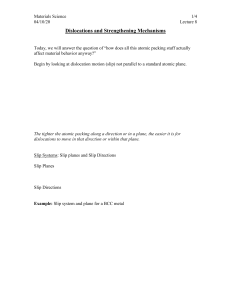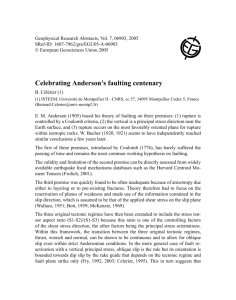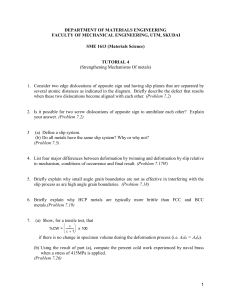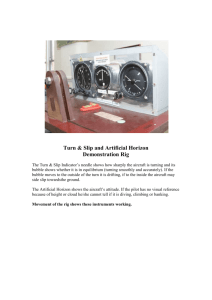MECHANICAL PROPERTIES OF MATERIALS
advertisement
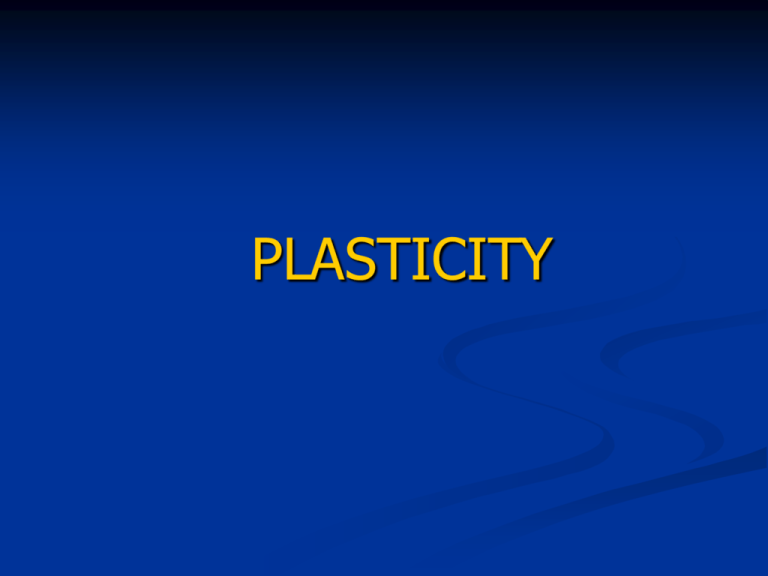
PLASTICITY
Dislocations and Materials Classes
• Ionic Ceramics (NaCl):
Motion hard.
-need to avoid ++ and - neighbors.
+
-
+
-
+
-
+
-
+
-
+
-
+
-
+
-
+
-
+
-
+
+
+
• Covalent Ceramics
(Si, diamond): Motion hard.
-directional (angular) bonding
• Metals: Disl. motion easier.
-non-directional bonding
-close-packed directions
for slip.
electron cloud
+
+
+
+
+
+
+
+
+
+
+
+
+
+
ion cores
+
+
+
+
+
+
+
+
Dislocation Motion
Dislocations and plastic deformation
Cubic & hexagonal metals - plastic deformation
by plastic shear or slip where one plane of
atoms slides over adjacent plane by defect
motion (dislocations).
• If dislocations don't move,
deformation doesn't occur!
Adapted from Fig. 7.1,
Callister 7e.
Dislocation Motion
Dislocation moves along slip plane in slip direction
perpendicular to dislocation line
Slip direction same direction as Burgers vector
Edge dislocation
Adapted from Fig. 7.2,
Callister 7e.
Screw dislocation
If a material is subjected to a load of
sufficient magnitude it shows permanent
(irrecoverable) deformation.
It is result of the permanent displacement of
atoms and molecules from their original
position.
If the deformation is continuously increasing
then the phenemenon is called FLOW.
P
Pn
x’
x
Slip plane
P
Ps
Slip
direction
Deformation Mechanisms
Slip System: Slip plane and direction
Slip plane - plane allowing easiest
slippage
- Highest planar densities
Slip direction - direction of movement
- Highest linear densities
FCC
FCC Slip occurs on {111} planes (close-packed) in
<110> directions (close-packed)
=> total of 12 slip systems in FCC
(111)
(111)
(111)
(111)
Parallel
(111)
So, for (111) plane:
3
(111), [101] or [101]---1
1
(111), [110] or [110]---2
2
(111), [011] or [011]---3
Therefore, for an FCC structure:
{111} - <110> , there are 12 slip systems.
To sum up:
Slip phenemenon is used to explain the plastic
behaviour of materials.
Slip occurs along certain crystal planes and
directions.
Slip planes & slip directions make slip systems.
For an FCC structure {111} - <110> , there are 12
slip systems.
For an BCC structure {110} - <111> → 12 slip
systems.
For an HCP structure → 3 slip systems.
The stress that initiates slip is known as the
critical resolved shear stress.
F
A
Ø: Angle between the
normal to the slip plane
and the applied stress
directions.
λ: Angle between the slip
and stress directions.
As
τCR = σ . cos λ . cos Ø
Stress and Dislocation Motion
• Crystals slip due to a resolved shear stress, tR.
• Applied tension can produce such a stress.
Applied tensile
stress: s = F/A
A
F
Resolved shear
stress: tR =Fs /A s
slip plane
tR = FS /AS
tR
normal, ns
AS
FS
F
Relation between
s and tR
Fcos l
F
tR
tR s cos l cos f
l
FS
A/cos f
nS f
A
AS
Fs= F cos λ (shear force along the slip direction)
As = A / cos Ø (shearing area)
τCR
F cos λ
F
Fs
=
=
=
As
A / cos Ø
A
τCR = σ cos λ cos Ø
σ
cos λ . cos Ø
Single Crystal Slip
Adapted from Fig.
7.9, Callister 7e.
Adapted from Fig. 7.8, Callister 7e.
Ex: Deformation of single crystal
a) Will the single crystal yield?
b) If not, what stress is needed?
f=60°
l=35°
tcrss = 30 MPa
t s cos l cos f
s 65 MPa
t (65 MPa) (cos 35 )(cos 60 )
Adapted from
Fig. 7.7,
Callister 7e.
(65 MPa) (0.41)
s = 65 MPa
t 26.62 MPa t crss 30 MPa
So the applied stress of 65 MPa will not
cause the crystal to yield.
Ex: Deformation of single crystal
What stress is necessary (i.e., what is the yield
stress, sy)? (!We will learn about yield stress later on!)
t crss 30 MPa s y cos l cos f s y (0.41)
t crss
30 MPa
s y
73.25 MPa
cos l cos f
0.41
So for deformation to occur the applied stress must
be greater than or equal to the yield stress
s s y 73.25 MPa
Ex: Consider a single crystal of BCC iron
oriented such that a tensile stress is applied
along [010] direction.
a) Compute the resolved shear stress along a
(110) plane and in a [111] direction when a
tensile stress of 52 MPa is applied.
b) If slip occurs for the above plane and
direction, and the critical resolved shear
stress is 30 MPa, calculate the magnitude of
the applied tensile stress necessary to
initiate yielding.
z
a)
Ø=45° angle b/w
normal [110] & stress
σ= 52MPa [010]
[110]
σ= 52
(110)
x
cos Ø =
y
1*0 + 1*1 + 0*0
1
=
√2
(12+12+02) (02+12+02)
Ø = 45°
λ: angle b/w slip direction [111] & stress direction [010]
cos λ =
-1*0 + 1*1 + 1*0
(12+12+12) (1)
1
=
√3
λ = 54.7°
τCR = 52 * cos 45 * cos 54.7 = 21.3 MPa
b) σy =
τCR
cos Ø cos λ
=
30
cos 45 cos 54.7
σy = 73.4 MPa
Slip Motion in Polycrystals
• Stronger - grain boundaries
pin deformations
s
• Slip planes & directions
(l, f) change from one
crystal to another.
Adapted from Fig.
7.10, Callister 7e.
(Fig. 7.10 is
courtesy of C.
Brady, National
Bureau of
Standards [now the
National Institute of
Standards and
Technology,
Gaithersburg, MD].)
• tR will vary from one
crystal to another.
• The crystal with the
largest tR yields first.
• Other (less favorably
oriented) crystals
yield later.
300 mm
Critical Resolved Shear Stress
• Condition for dislocation motion:
tR tCRSS
• Crystal orientation can make
it easy or hard to move dislocation
tR s cos l cos f
s
tR = 0
l =90°
t
typically
10-4 GPa to 10-2 GPa
s
s
tR = s/2
l =45°
f =45°
maximum at l = f = 45º
tR = 0
f =90°
DISLOCATIONS
&
σ-ε CURVES
I
II
III
Elastic Region: σy is the stress required to start
plastic deformation. It is called the yield stress.
From σy & on → plastic deformation starts.
Stage I: dσ/dε ≈ 0 (work hardening rate) is
low because only the primary slip systems are
active. The slip planes are parallel to each
other and only these parallel planes will slip
and they do not intersect themselves, i.e.
dislocations are moving along parallel planes.
Stage II: Other dislocations will start to move
along intersecting planes (more than one slip
system becomes active). Therefore they form
barriers to one another’s motion. It becomes
harder to further deform the material. This
stage is known as Work Hardening Stage.
Stage III: The geometry of the planes have
so changed that the planes will accelerately
slip and failure will occur.

